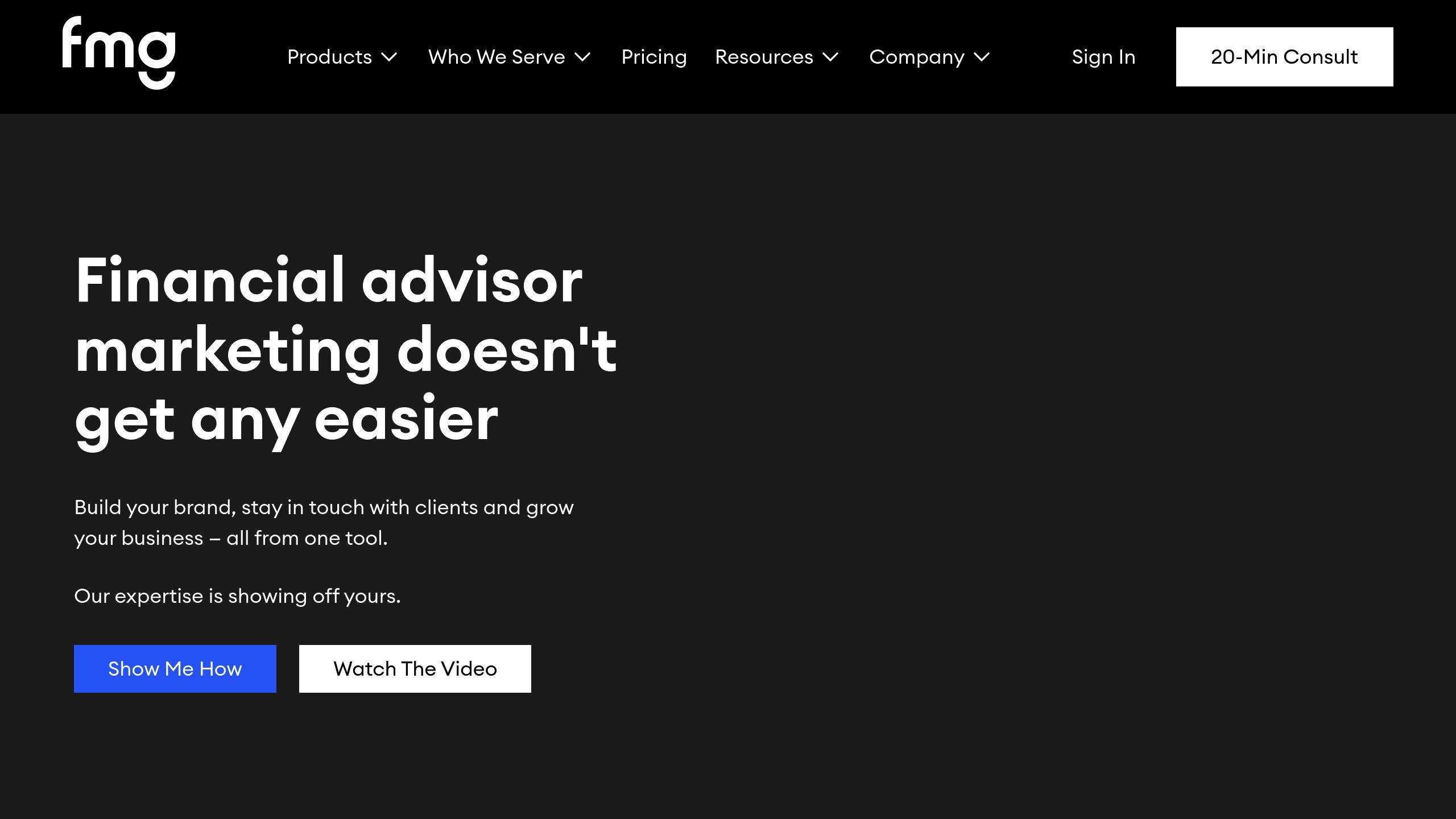Referrals are one of the most effective ways financial advisors can grow their practice, with 58% of high-net-worth individuals finding their advisors through recommendations. But asking for referrals can feel uncomfortable. Here's how to do it naturally and professionally:
- Ask at the right time: Right after helping a client achieve a financial goal.
- Keep it casual: Turn it into a conversation about success or ask for advice, e.g., "Who else might benefit from this guidance?" or "How would you connect with more clients like you?"
- Use tools: Leverage LinkedIn, CRM systems, and partnerships with CPAs or attorneys to streamline and enhance referral opportunities.
- Respect boundaries: Pay attention to client comfort and never push too hard.
- Show gratitude: Send thank-you notes and keep clients updated.
Referrals bring trust and better client alignment, but only 3% to 5% of referrals lead to meetings. Timing, professionalism, and the right tools can make all the difference.
How to Ask for Referrals Without Being Pushy
When it comes to referrals, the key is to keep the conversation natural and focused on the value you bring to your clients. Here's how to request referrals in a way that's both professional and comfortable.
Choosing the Right Moment
Timing is everything. The ideal time to ask for a referral is right after you've delivered clear results - like helping a client reach a financial goal or solve a tough problem. Considering that only 3% to 5% of referrals lead to meetings [1], asking at the right time can make a big difference.
Keeping It Casual and Collaborative
Turn your referral request into part of a larger conversation about your client's success. This way, it feels less like a favor and more like a natural extension of your partnership.
Here are two ways to approach it:
-
Celebrate success together:
"I'm so glad we could help you reach your financial goals. Is there anyone else you know who might benefit from this kind of guidance?" [2]
-
Ask for advice:
"If you were in my position, how would you go about connecting with more clients like you?" [1]
Both approaches shift the focus from "asking for something" to strengthening your relationship. By highlighting your shared achievements and showing genuine interest in their perspective, you can encourage referrals without making the conversation feel forced.
Once you're comfortable asking for referrals, the right tools can help you make the process even smoother.
Tools and Techniques for Generating Referrals
Here’s a look at some effective tools and methods to make professional referral generation easier and more efficient.
Using LinkedIn and Social Media for Networking
LinkedIn is a great platform for building referrals within your network. Here’s how you can make the most of it:
- Leverage your connections: Look for potential introductions through your current clients' networks.
- Showcase your expertise: Share valuable insights and engage meaningfully with your connections.
As Julie Littlechild puts it, "personal and social referrals are most effective" [1].
Building Referral Partnerships with Complementary Professionals
Collaborate with professionals like CPAs, estate attorneys, or insurance agents to create mutually beneficial partnerships. These partnerships can include co-hosting events or establishing referral agreements. Key benefits of such collaborations include:
- Reaching the same client base with services that complement each other.
- Enhancing offerings without stepping outside your area of expertise.
- Naturally creating referral opportunities through shared client education efforts.
Automating Referral Follow-Ups with CRM Tools
CRM tools can simplify and organize your referral process by helping you:
- Keep track of where referrals come from.
- Automate follow-ups to stay connected.
- Monitor how referrals convert into clients.
- Schedule regular check-ins with referral partners.
Combining personal outreach with automated systems ensures conversations lead to actionable referrals.
For more ideas, Financial Advisor Marketing provides a detailed list of 51 marketing tools tailored for financial advisors aiming to grow their practice through referrals.
With these strategies and tools, you can focus on maintaining professionalism and earning trust throughout the referral process.
Maintaining Professionalism in Referral Requests
Building Trust Before Asking
Before requesting referrals, it’s important to establish trust and provide clear value to your clients. Focus on delivering top-notch service by customizing financial plans, offering regular portfolio updates, staying in touch proactively, and sharing educational materials tailored to their needs.
Respecting Client Boundaries
Timing and sensitivity are key when discussing referrals. Pay close attention to signs that a client may feel uncomfortable - like hesitation, changes in body language, or outright refusal. If you notice these cues, acknowledge their feelings and shift the topic naturally to preserve the relationship.
By honoring their comfort levels, you create an atmosphere where referrals feel genuine and welcome.
Expressing Gratitude for Referrals
Always show your appreciation in a thoughtful way. Send a personalized thank-you note within 24 hours of receiving a referral, keep clients updated on progress (while respecting confidentiality), and consider meaningful gestures like exclusive insights or invitations to special events.
A professional yet heartfelt thank-you can deepen your client relationships and encourage them to refer others in the future.
sbb-itb-e3190ce
Additional Resources for Financial Advisors
Building your practice through referrals requires the right mix of tools and strategies. Here are some resources tailored to help financial advisors improve their referral efforts.
Tools for Financial Advisor Marketing

Financial Advisor Marketing provides a free list of 51 tools to help advisors grow their practice organically. These tools focus on areas like:
- Improving referral campaigns: Tools to track and manage referral programs effectively.
- Strengthening client connections: CRM systems and communication platforms.
- Boosting online visibility: Social media and content marketing resources.
Since only 3% to 5% of client referrals result in meetings, having the right tools is crucial for increasing conversion rates [1]. Pairing these tools with targeted email outreach can further refine your referral approach.
Email Outreach Solutions
Affordable email tools, such as the Email Scraping Tool, can simplify lead generation and help create targeted prospect lists. These tools allow advisors to:
- Build precise prospect lists.
- Simplify the lead generation process.
- Connect with potential referral sources more effectively.
Expanding Your Professional Network
Joining professional associations is another way to discover referral opportunities and build mutually beneficial relationships. Groups like attorney associations, CPA networks, and local business forums provide excellent platforms for forming partnerships that can lead to referrals.
Building a Practice Driven by Referrals
Generating referrals starts with recognizing this simple truth: satisfied clients are far more likely to recommend your services. Asking them how financial planning has positively influenced their lives can make the referral process feel more personal and authentic [1].
To encourage steady referral growth, focus on these three essential factors:
- Well-Timed Requests and Strong Client Relationships: Look for the right moments to ask for referrals, such as after delivering outstanding results. Maintain professionalism by showing genuine gratitude and keeping communication respectful [4].
- Smart Use of Technology and Professional Networks: Leverage CRM tools to manage relationships and streamline referral tracking. Collaborate with professionals like attorneys and CPAs to open up new referral opportunities, while also using digital platforms to nurture these connections [3].
FAQs
How to ask for referrals without sounding desperate?
Carl Richards points out that people often enjoy helping others, especially when there's a personal connection. You can use this idea to make your referral requests feel more natural and less forced.
To keep things comfortable, approach referral requests as conversations about shared success. Bring them up during moments when clients are most engaged - like after hitting milestones or during review meetings. This way, the focus stays on the value you've provided.
Here are a couple of ways to approach it:
-
Turn it into a conversation: Ask open-ended questions like:
"If you were me, how would you go about finding more clients like you?" [1]
- Highlight specific results: Talk about the outcomes you've achieved together. This keeps the focus on the value you've delivered, rather than making it feel like you're asking for a favor.
Even though only 3-5% of referrals lead to meetings, research shows that up to 35% of clients have referred their advisors. This underscores the importance of timing and thoughtful requests [1].
What are the most effective ways to follow up on referrals?
Use CRM tools to keep track of referrals, automate your follow-ups, and maintain a professional tone. The challenge is finding the right balance - be persistent, but always respect both the referrer and the potential client [2].
When is the best time to ask for referrals?
The ideal time to ask for referrals is after you've delivered clear results or during meaningful client interactions. As mentioned earlier, focus on quality over quantity - this helps preserve professional relationships and ensures you don't come across as overly eager [5].


